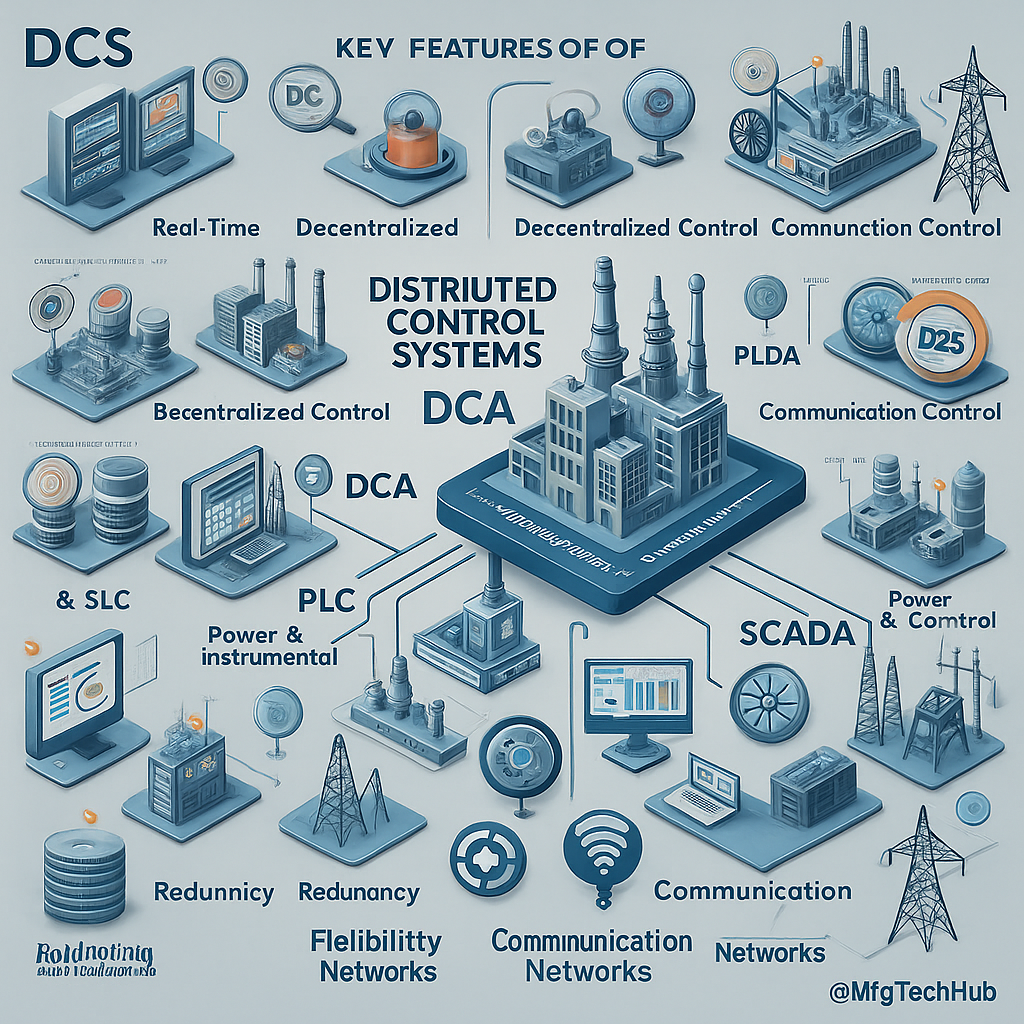Introduction to Distributed Control Systems (DCS)
What is a Distributed Control System (DCS)?
A Distributed Control System (DCS) is an automated control architecture widely used in process industries to monitor, control, and optimize operations. Unlike centralized control systems, where a single controller governs the entire plant, a DCS distributes intelligence across multiple local controllers. These controllers are networked together and communicate seamlessly, providing higher reliability, scalability, flexibility, and fault tolerance.
DCS has become a cornerstone of modern industrial automation because it combines the power of advanced control algorithms with real-time data visualization. This ensures operators can detect problems early, make quick decisions, and maintain system stability even in the most complex environments.

Visual overview of Distributed Control System (DCS) architecture and components including PLCs, SCADA, HMI, communication networks, and real-time control systems
Key Features of DCS
- Decentralized Control: Instead of a single control unit, tasks are distributed across multiple controllers located near the process. This improves reliability and reduces single points of failure.
- Real-Time Process Monitoring: Continuously tracks process variables such as temperature, flow, and pressure, ensuring stability and performance.
- High Reliability & Fault Tolerance: Built-in redundancy ensures uninterrupted operation even if one controller or network fails.
- Scalability & Flexibility: Modular design allows easy expansion as plant capacity grows or production lines are added.
- Integrated Communication Networks: Supports standard industrial protocols like Modbus, PROFIBUS, Ethernet/IP, OPC-UA, and newer IIoT-ready protocols for data exchange.
- User-Friendly Human-Machine Interface (HMI): Provides operators with intuitive dashboards, alarm management, and control options.
How DCS Works
A DCS typically consists of multiple layers, each responsible for different aspects of plant control:
- Data Collection: Field devices such as sensors measure process variables like flow rates, pressures, and temperatures in real time.
- Processing & Control: Distributed controllers (often using PID or advanced model-based algorithms) analyze incoming signals and determine corrective actions.
- Actuation: Commands are sent to actuators (valves, pumps, motors) to adjust process parameters.
- Visualization & Monitoring: Operators view data trends, alarms, and process states via HMIs and control room panels.
- Data Storage & Analysis: Historical data is logged in databases for reporting, performance optimization, and compliance purposes.
This layered structure makes DCS highly adaptable and capable of controlling both continuous and batch processes.
DCS vs. Other Control Systems
Although DCS shares similarities with PLCs (Programmable Logic Controllers) and SCADA (Supervisory Control and Data Acquisition), its purpose and design differ. Here’s a quick comparison:
| Feature | DCS | PLC (Programmable Logic Controller) | SCADA (Supervisory Control and Data Acquisition) |
|---|---|---|---|
| Control Type | Distributed | Centralized or Modular | Supervisory & Remote Monitoring |
| Best For | Large-scale continuous processes (refineries, power plants) | High-speed discrete automation (assembly lines, packaging) | Remote monitoring, reporting, and data collection |
| Reliability | High, with built-in redundancy | Medium, depends on system design | High, but focused more on visibility than direct control |
| Scalability | Very scalable for plant-wide operations | Moderately scalable | Limited to supervisory roles |
Industries That Use DCS
DCS systems are essential in industries where continuous processes and high reliability are required. Some examples include:
- Oil & Gas: Used for refining, pipeline management, and offshore production platforms.
- Power Generation: Controls boilers, turbines, and ensures grid stability in thermal and nuclear plants.
- Chemical & Petrochemical: Optimizes reactors, distillation units, and ensures compliance with safety standards.
- Pharmaceuticals: Manages batch processes, ensures consistency, and tracks compliance with regulatory frameworks.
- Water & Wastewater Treatment: Controls filtration, chemical dosing, and effluent treatment to meet environmental standards.
Advantages of DCS
The benefits of a DCS extend beyond just automation—they fundamentally reshape how industries operate:





Real-World Example of DCS in Action
Consider a power generation plant using a DCS. Boilers, turbines, and cooling towers all need to be synchronized for safe and efficient energy production. Through distributed controllers, DCS monitors parameters such as steam pressure and temperature in real time. If pressure rises beyond safe limits, the DCS automatically adjusts valves and alerts operators. Historical data logged by the system also helps engineers fine-tune performance and reduce fuel consumption over time.
Similarly, in a pharmaceutical batch process, DCS ensures strict adherence to recipes by controlling mixing times, heating cycles, and ingredient quantities. This consistency not only maintains quality but also ensures regulatory compliance.
The Future of DCS
As industries evolve, DCS systems are becoming smarter and more connected. Integration with Industrial Internet of Things (IIoT), Artificial Intelligence (AI), and cloud computing is enhancing their capabilities. Predictive analytics powered by AI can detect anomalies before failures occur. Cloud integration enables remote monitoring and global collaboration, while IIoT sensors expand the scope of data collection.
Cybersecurity is another key area of development. As DCS systems become more networked, protecting them from cyber threats is critical. Vendors are embedding robust security measures to safeguard operations while maintaining seamless connectivity.
Conclusion
A Distributed Control System (DCS) is more than just a control solution—it is the backbone of reliable, efficient, and safe industrial automation. By distributing intelligence across controllers, integrating advanced communication protocols, and providing user-friendly interfaces, DCS ensures industries can run smoothly even under demanding conditions.
Looking ahead, the role of DCS will only grow stronger as it integrates with digital transformation initiatives. For industries aiming to embrace Industry 4.0, DCS offers the foundation for smarter, data-driven, and resilient operations.
